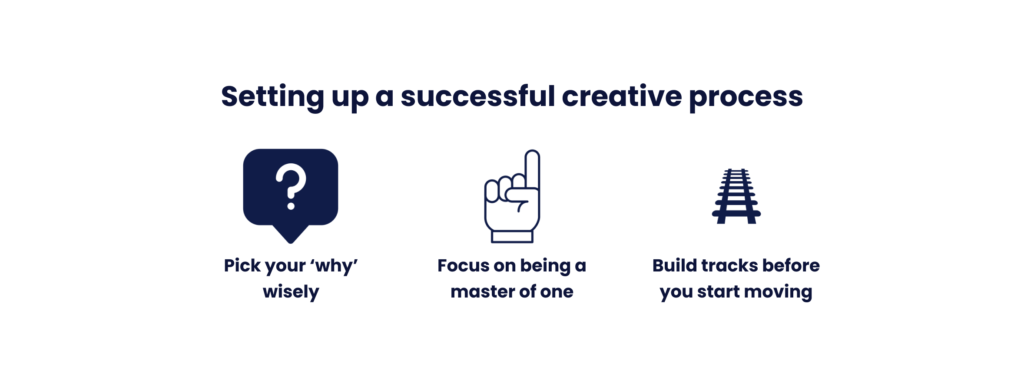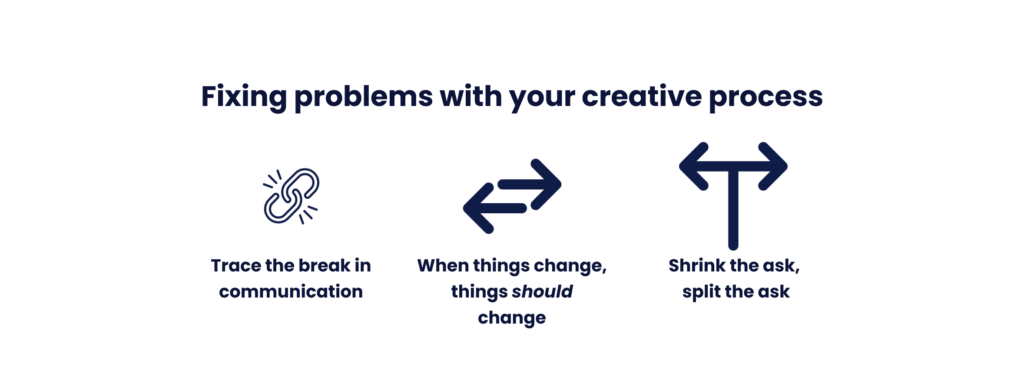Best Practices for Building an Effective Creative Process
Published
March 17, 2023
Updated
March 17, 2023

Is there a better feeling as a marketer than launching new advertising creative and having it nail all your goals? It feels like magic. But while lightning strikes occasionally, repeated success in this area isn’t luck—it’s about establishing an effective creative process that gets the boring (but necessary) stuff right so your creative team can make something special.
How to Build an Effective Creative Process
Here are three steps to set yourself up for a successful creative process:

- Pick your “why” wisely. It’s not enough to make a new ad because you have a new product and want people to know about it. That’s the company’s motivating factor—but people might not care. You also need to hit on solving a customer problem and giving them a reason to care about your new product. The best kind of customer problem is one that your company can uniquely (and realistically) solve. “I’m stressed” is too general. But “I’m stressed because my hair is on fire” is the perfect problem for your company’s fire extinguisher/hair spray product. This specificity gives your creative team what they need to explore the right space and connect with your potential customers.
- Focus on being a master of one. Great creative can do almost anything, but it can’t do everything. Is it a brand spot or direct response? Are you talking about a new product or an old one? Is it talking to your younger demo or your older one? Any choice works, you just need to make it before your creative team starts working. Forgettable creative tries to talk to everyone and say everything, and yet it does nothing. Take a deep breath and pick what’s most important. You’ll get other chances for other choices. Clear limitations up front help your creatives from going down dead ends.
- Build tracks before the creative train gets moving. Once production starts, things will move quickly, and fixing mistakes will be difficult. Before your creative team starts work, take a minute to align with all necessary stakeholders and collaborators on expectations. What’s everyone’s role? How do we solve disagreements? Who gets the final say? What’s the one thing we all agree we’re trying to do here? It might feel like you don’t have time to do this step, but robust agreement and alignment are powerful timesavers. You’ll want to uncover any issues now because it only gets trickier from here.
Fixing Problems with Your Creative Process
In an ideal world, all creative best practices are always followed, your project gets set up perfectly, and there are no surprises. But since we’re entering into the world of creative magic and unknowns, things can (and will) go sideways, even when you’ve done everything right. Keep your cool, act intentionally, and you and your creatives should be able to right the ship.

- Trace the break in communication. If the creative isn’t where it needs to be, it could be due to a gap in context. Get together and go back to why you’re making this in the first place. Then get curious about the choices that your team has made to pull it off. By getting curious you can see if there’s a misalignment on goals (they’re trying to make it brand instead of direct response), tactics (there’s a misread on what would speak to the customer), or resources (there’s not enough skill, time, or money to do what you want to do).
- When things change, things should change. You know more about the project when you’re part way through than when you started. Maybe the work’s taking longer than expected. Maybe there are legal concerns. A new fire drill request is pulling the team’s focus. Don’t ignore this new information. Get your team together, present what you’ve seen, and gather ideas on the best way to move forward now that you know more. Decide together, with a plan to revisit if things change again.
- Shrink the ask, split the ask. We said we’d be a master of one, but after new stakeholder notes, we’re now a “master of one more thing.” If it’s worth doing, it deserves its own test. Don’t make your creative team scramble to keep up with scope bloat. Queue up new scope-increasing requests as new projects that are scheduled to start after this project is done. Your creative teams' brains will thank you.
And as a bonus, when your project is shipped, the last step is a retrospective, giving everyone who worked on it a chance to share what went well, what could’ve been better, and what could be changed for next time. That ensures your process and working relationship with your creative team keep improving project after project.
Making great, reel-worthy, ROI-smashing creative is never guaranteed, but if you establish an effective creative process, clear the runway for your creative team, and troubleshoot with curiosity and a calm head, the muses have a way of stopping by a lot more often.
.webp)
.webp)
.webp)
.webp)
.webp)
.webp)
.svg)
.svg)
.svg)
.png)


.png)







.png)

.webp)
.webp)
.webp)
.webp)
.webp)
.webp)